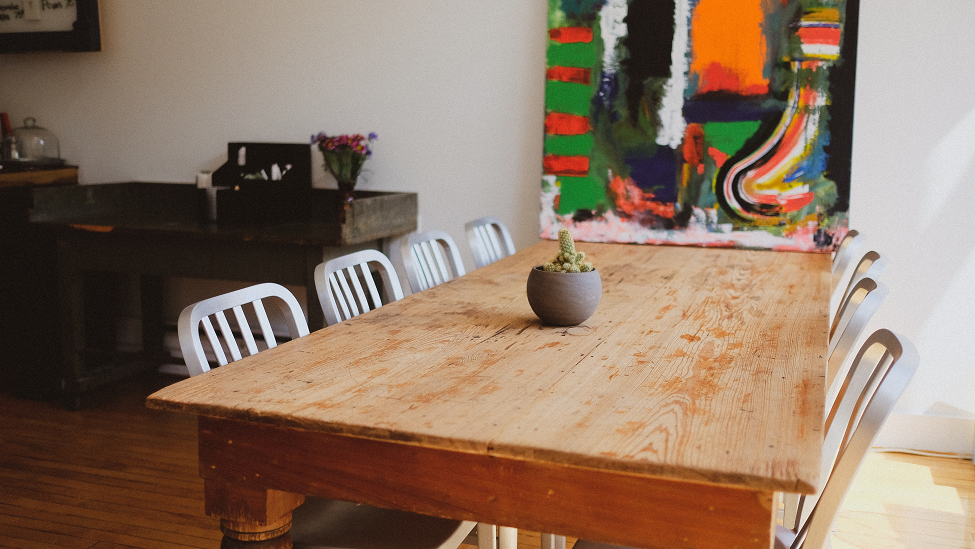You’ve invested in a beautiful cherry dining set, a mahogany desk, or a walnut china cabinet. Keep them all looking their best by cleaning your wood furniture correctly.
The first step in properly cleaning wood furniture is understanding the type of finish your wood furniture has. A finish enhances the appearance of the wood and protects it from sunlight, moisture, scratches, and any other daily trauma it might encounter. A finish also seals the wood, creating a barrier between the raw wood and any germs and bacteria that would seep into the wood’s pores.
Cleaning Wood Laminate
Made with synthetic materials of very thinly sliced pieces of wood, laminate typically has a shiny finish and is used on pieces that need to be durable. Laminate is very easy to clean with a microfiber cloth using soapy water. It is important to thoroughly wipe laminate dry and always use a coaster for drinks since long exposure to water (like a cold glass of lemonade or a steamy cup of coffee) will leave rings on your laminate surfaces.
The most important thing to remember is to avoid using ammonia-based cleaners on laminate and veneer surfaces. These chemicals can cause damage and create a cloudy look on the surface.
Cleaning Wood Veneer
Veneer is a thin (usually less than 1/8 of an inch) layer of hardwood bonded to a less expensive surface hidden below. This process allows manufacturers to design beautiful pieces of furniture at a fraction of the cost of solid wood.
As with laminate furniture, coasters are a must with wood veneer. Condensation and spills will permanently damage the veneer, so cleaning your veneer wood furniture quickly is key when spills happen. Soapy water on a microfiber cloth is the way to go when cleaning your veneer wood furniture. Avoid harsh and abrasive cleaners and the frequent use of wax products to avoid build-up and simply dust the surfaces regularly.
Cleaning Wood Oil Finishes
Versatile and easy to apply, wood oil finishes are classified as “drying oils; oils that harden as they dry to create a protective finish. These include linseed oil, tung oil, and walnut oil. These oils contain high levels of polyunsaturated fatty acids derived from plant oils and can take weeks to months to properly “cure.”
Wood oil finishes can be buffed to a matte or gloss finish and are often coated with paste wax for extra protection. Oil finishes do require occasional reapplication on high-traffic pieces, like tables, to keep up its protection.
Tung oil, also called “Danish Oil,” is light in color and produces a matte or satin finish. While it doesn’t offer as much in the way of protection as some other oils we’ll discuss, it does offer water resistance. When tung oil dries upon exposure to air, the resulting coating is transparent and has a deep, almost wet, look that, after numerous coats, can look almost like plastic.
Linseed oil, also known as flax or flaxseed oil, can be used on its own or blended with combinations of other oils as a varnish, pigment binder, or a plasticizer. Linseed oil, like tung oil, does not offer much in Linseed oil, also known as flax or flaxseed oil, dries slowly and offers almost no protection against scratches, but it does soak into the wood to help highlight the wood’s grain. Wood oiled with linseed oil can darken and yellow over time, and outdoor furniture treated with linseed oil may develop mildew. It should also be noted that linseed oil provides little to no water-resistance.
Walnut oil is favored by woodworkers because of its safety, especially in pieces like bowls, platters, and utensils, that will come in direct contact with food. Walnut oil dries quickly and is often mixed with beeswax to formulate wood finishes.
Cleaning Lacquered Wood Finishes
The term lacquer is used for several hard, durable, waterproof, and flexible finishes applied to wood and polished to a high sheen. Lacquers provide high gloss and an ultra-smooth finish because they are thinner than other finishes and is applied via a sprayer. Lacquer dries clear and hard, but because of its high shine, any scratch in the wood is obvious. Some lacquer tends to yellow as it ages and can shrink as well (called “crazing”).
Always wipe spills immediately. Lacquer is easily damaged with water and if you do not take heed of this warning, you will end up with lackluster and cracked furniture. Lacquered wood furniture should be cleaned with a damp (not sopping wet) microfiber cloth using strokes instead of a circular motion. Dry with a soft cloth can avoid corrosive cleaners, like ammonia or bleach.
Cleaning Varnished Wood Finishes
The term varnish is often used generically for a finish or topcoat and is a transparent hard protective finish or film. It is a natural state, a varnish has no color, but it mixed with pigment and sold commercially in several shades. Varnish is primarily used to seal wood where the distinctive tone and grains of the wood are meant to be visible. Varnish also supplies natural UV protection for wood.
To remove stickiness or light soil wipe with a damp cloth. Follow up by rubbing with a dry cloth immediately. Test in an inconspicuous spot before you do this because you do not want to damage the furniture, and never leave a damp cloth sitting on the varnished surface. To protect varnished wood, apply a coat of paste wax. You don’t need to do this very often. While applying wax helps protect from moisture and dust, never do this more than once a year to prevent wax buildup.
Cleaning Shellacked Wood Finish
Originally developed as a dye, shellac is available in clear and rich orange or garnet colors. It creates a hard surface on the wood the protects against water, but it can be affected by heat (always use a potholer or other protection when setting something hot on a piece of shellacked wood).
If your shellac finish is in good condition and just needs cleaning, use a mild, biodegradable liquid dishwashing soap diluted in warm water. Ring the rag out very well before you wipe the shellac surface.
To schedule your cleaning service, contact us today at 888-302-5582 or visit with branches in Atlanta, GA, Charleston, SC, Greenville, SC.
LET US DO THE CLEANING. YOU DO THE RELAXING.






